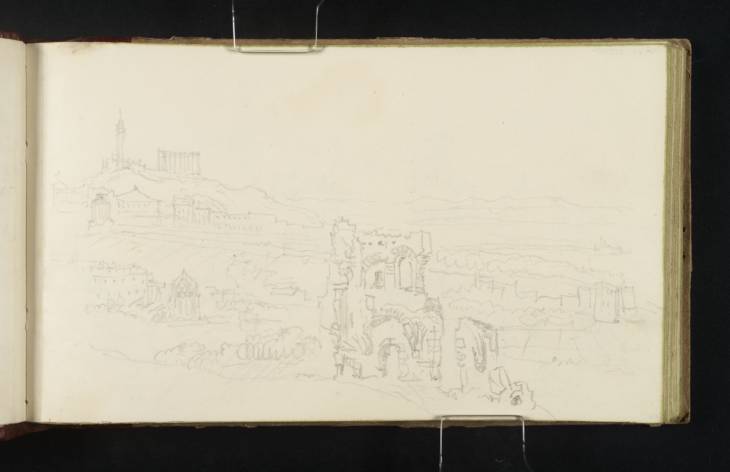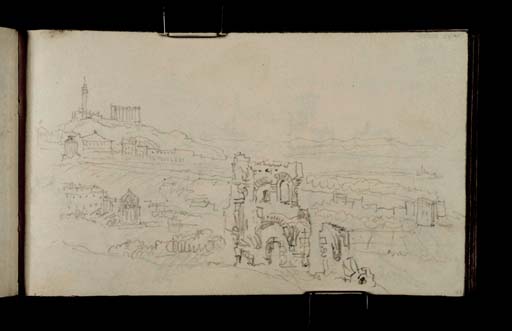Joseph Mallord William Turner Edinburgh from St Anthony's Chapel, with Holyrood and Calton Hill 1834
Image 1 of 2
Joseph Mallord William Turner,
Edinburgh from St Anthony's Chapel, with Holyrood and Calton Hill
1834
Joseph Mallord William Turner 1775–1851
Folio 89 Verso:
Edinburgh from St Anthony’s Chapel, with Holyrood and Calton Hill 1834
D26431
Turner Bequest CCLXIX 89a
Turner Bequest CCLXIX 89a
Pencil on off-white wove paper, 113 x 190 mm
Inscribed in pencil by Turner ?‘Borders’ bottom right
Inscribed in pencil by Turner ?‘Borders’ bottom right
Accepted by the nation as part of the Turner Bequest 1856
References
1909
A.J. Finberg, A Complete Inventory of the Drawings of the Turner Bequest, London 1909, vol.II, p.867, CCLXIX 89a, as ‘St. Anthony’s Chapel, with Holyrood and Calton Hill.’.
1990
Dr David Wallace-Hadrill and Janet Carolan, ‘Turner’s Sketches North of Stirling’, Turner Studies: His Art and Epoch 1775 – 1851, Vol.10 No.1, Summer 1990, p.12.
The drawing across this page and folio 90 (D26432) is the last in a series of sketches of Edinburgh from St Anthony’s Chapel in Holyrood Park. The series probably begins on folio 81 verso (D26415) and continued almost uninterrupted until folio 90: folios 81 verso–84 verso, 85 verso–87 verso and 88 verso–90 (D26415–D26421, D26423–D26427, D26429–D26432).
The sketches were made in preparation for a watercolour of Edinburgh from St Anthony’s Chapel circa 1834 (whereabouts unknown)1 which had been commissioned to illustrate the first volume of Tales of a Grandfather in Robert Cadell’s new edition of Sir Walter Scott’s Prose Works. The view may also have been considered as a possible illustration to Scott’s novel The Heart of Midlothian, 1818.2 Turner made the sketches on 1 October after visiting several sites in the city with the edition’s publisher Robert Cadell.3
The sketches are at first rough and tentative, showing various views from the slopes of Arthur’s Seat near the chapel but without displaying any real sense of composition. The genesis of a finished picture emerges on folio 88 verso (D26429) with alternative compositions on folios 89 (D26430) and the present page. These sketches not only have a stronger composition but are also more finished and contain more information and detail. The present sketch is the culmination of the series. It is highly composed and detailed, and the most highly worked and carefully executed.
The Prose Works design is not based on any single one of these sketches. Instead, Turner used the whole series as source material, taking details from a number of sketches and from sketches made elsewhere in the city, and manipulating the elements to form a more satisfactory composition. He is likely also to have referred to sketches made on previous visits to Scotland, as well as relying on memory. The composition of the Prose Works design, and some of its details, recall a drawing of the same subject made during Turner’s 1801 visit to Scotland. Edinburgh from St Anthony’s Chapel, 1801 (Fogg Art Museum, Harvard University Art Museum, Cambridge, USA) is a carefully executed, though unfinished, pencil drawing of the view. Like the watercolour, but unlike any of the sketches in the Stirling and Edinburgh book, the ruins of St Anthony’s Chapel appear to the right of Edinburgh Castle. Certain details – the chapel ruins, the castle, the crown spire of St Giles’s Cathedral and Holyrood Palace – are all similar in the Prose Work design, and the 1801 drawing, suggesting that Turner referred to it alongside his 1834 sketches.
On the current page, drawn with the sketchbook inverted, is the right half of the view from Arthur’s Seat. The ruins of St Anthony’s Chapel appear in the foreground, the most detailed sketch that Turner made of them in 1834. To the left is Holyrood Palace with the ruins of Holyrood Abbey at the right. Above is the Robert Burns Memorial and above that on Calton Hill are the Nelson Monument and the half-built National Monument. Most of the city, including Edinburgh Castle, is shown on folio 90 where the sketch continues.
Thomas Ardill
November 2010
Robert Cadell approached Turner in 1833 to illustrate his new edition of the Waverley Novels. Turner eventually turned down the commission, and Cadell was forced to seek other artists to complete the illustrations. He seems to have selected many of the same subjects that he first suggested to Turner. For Cadell’s ‘Abbotsford edition’ of the publication, Clarkson Stanfield illustrated ‘Edinburgh from St Anthony’s Chapel’ for the Heart of Midlothian: Sir Walter Scott, Waverley Novels [Abbotsford Edition], vol.3, Edinburgh 1843, title-page.
How to cite
Thomas Ardill, ‘Edinburgh from St Anthony’s Chapel, with Holyrood and Calton Hill 1834 by Joseph Mallord William Turner’, catalogue entry, November 2010, in David Blayney Brown (ed.), J.M.W. Turner: Sketchbooks, Drawings and Watercolours, Tate Research Publication, December 2012, https://www


